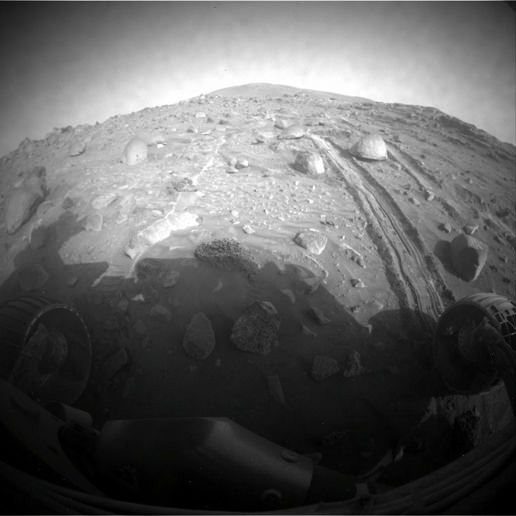[/caption]
Spirit is taking the long way around a low plateau called “Home Plate,” after loose soil at the edge blocked the shortest route south for the upcoming Martian summer and following winter. The rover has begun a trek skirting at least partway around the plateau instead of directly over it.
NASA officials say even a circuitous route to the destinations chosen for Spirit will be much shorter than the overland expedition the rover’s twin, Opportunity, is making on the opposite side of Mars. And they’re pointing out that Spirit has gotten a jump on its summer science plans, examining a silica-rich outcrop that adds information about a long-ago environment that had hot water or steam.

Both of NASA’s Mars Exploration Rovers landed on Mars in 2004 for what were originally planned as three-month missions.
Spirit spent 2008 on the northern edge of Home Plate, a flat-topped deposit about the size of a baseball field, composed of hardened ash and rising about 1.5 meters (5 feet) above the ground around it. There, the north-facing tilt positioned Spirit’s solar arrays to catch enough sunshine for the rover to survive the six-month-long Martian winter.
The scientists and engineers who operate the rovers chose as 2009 destinations a steep mound called “Von Braun” and an irregular, 45-meter-wide (150-foot-wide) bowl called “Goddard.” These side-by-side features offer a promising area to examine while energy is adequate during the Martian summer. They’ll also provide the next north-facing winter haven beginning in late 2009. Von Braun and Goddard intrigue scientists as sites where Spirit may find more evidence about an explosive mix of water and volcanism in the area’s distant past. They are side-by-side, about 200 meters, or yards, south of where Spirit is now.
It’s mid-spring now in the southern hemisphere of Mars. The Sun has climbed higher in the sky over Spirit in recent weeks.
The rover team tried to drive Spirit onto Home Plate, heading south toward Von Braun and Goddard. They tried this first from partway up the slope where the rover had spent the winter. Only five of the six wheels on Spirit have been able to rotate since the right-front wheel stopped working in 2006. With five-wheel drive, Spirit couldn’t climb the slope. In January and February, Spirit descended from Home Plate and drove eastward about 15 meters (about 50 feet) toward a less steep on-ramp. Spinning wheels in loose soil led the rover team to choose another option.
“Spirit could not make progress in the last two attempts to get up onto Home Plate,” said rover project manager John Callas of NASA’s Jet Propulsion Laboratory in Pasadena, California. “Alternatively, we are driving Spirit around Home Plate to the east. Spirit will have to go around a couple of small ridges that extend to the northeast, and then see whether a route east of Home Plate looks traversable. If that route proves not to be traversable, a route around the west side of Home Plate is still an option.”
During the drive eastward just north of Home Plate in January, Spirit stopped to use tools on its robotic arm to examine a nodular, heavily eroded outcrop dubbed “Stapledon,” which had caught the eye of rover-team scientist Steve Ruff when he looked at images and infrared spectra Spirit took from its winter position.
“It looked like the material east of Home Plate that we found to be rich in silica,” said Ruff, of Arizona State University in Tempe. “The silica story around Home Plate is the most important finding of the Spirit mission so far with regard to habitability. Silica this concentrated forms around hot springs or steam vents, and both of those are favorable environments for life on Earth.”
Sure enough, Spirit’s alpha particle X-ray spectrometer found Stapledon to be rich in silica, too. Researchers plan to use Spirit’s thermal emission spectrometer and panoramic camera to check for more silica-rich outcrops on the route to Von Braun and Goddard. However, the team has set a priority to make good progress toward those destinations. Winds cleaned some dust off Spirit’s solar panels on Feb. 6 and Feb. 14, resulting in a combined increase of about 20 percent in the amount of power available to the rover.
Oppy, meanwhile, shows signs of increased friction in its right-front wheel. The team is driving the rover backwards for a few sols, a technique that has helped in similar situations in the past, apparently by redistributing lubricant in the wheel. Opportunity’s major destination is Endeavour Crater, about 22 kilometers (14 miles) in diameter and still about 12 kilometers (7 miles) away to the southeast. Opportunity has been driving south instead of directly toward Endurance, to swing around an area where loose soil appears deep enough to potentially entrap the rover.
Source: NASA


They should mention, as with Hubble images, “False colours” on their rover pictures…That panorama has “overlay colour filter” written all over it, though it does give a nice idea of where the rover is.
Still don’t understand why they do this.
The article says;
“Opportunity has been driving south instead of directly toward Endurance, to swing around an area where loose soil appears deep enough to potentially entrap the rover.”
Good idea, with all that silica around it might end up in sticky end in quicksand. Tad embarrassing that.